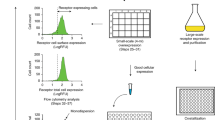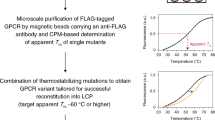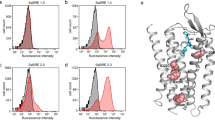Abstract
Glycoproteins are involved in diverse biological processes ranging from extracellular contact and recognition to intracellular signaling. Crystal structures of glycoproteins would yield tremendous insight into these processes. But glycoprotein structural analysis has been hindered by difficulties in expressing milligram quantities of stable, homogeneous protein and determining which modifications will yield samples amenable to crystallization. We describe a platform, which we have proven to be effective for rapidly screening expression and crystallization of a challenging glycoprotein target. In this protocol, multiple glycoprotein ectodomain constructs are produced in parallel by transient expression of adherent human embryonic kidney (HEK) 293T cells and are subsequently screened for crystals in microscale quantities by free interface diffusion. As a result, recombinant proteins are produced and processed in a native, mammalian environment, and crystallization screening can be accomplished with as little as 65 μg of protein. Moreover, large numbers of constructs can be generated, screened and scaled up for expression and crystallization, with results obtained in 4 weeks.
This is a preview of subscription content, access via your institution
Access options
Subscribe to this journal
Receive 12 print issues and online access
$259.00 per year
only $21.58 per issue
Buy this article
- Purchase on Springer Link
- Instant access to full article PDF
Prices may be subject to local taxes which are calculated during checkout






Similar content being viewed by others
References
Kwong, P.D. et al. Probability analysis of variational crystallization and its application to gp120, the exterior envelope glycoprotein of type 1 human immunodeficiency virus (HIV-1). J. Biol. Chem. 274, 4115–4123 (1999).
Cockett, M.I., Bebbington, C.R. & Yarranton, G.T. High level expression of tissue inhibitor of metalloproteinases in Chinese hamster ovary cells using glutamine synthetase gene amplification. Biotechnology 8, 662–667 (1990).
Cereghino, J.L. & Cregg, J.M. Heterologous protein expression in the methylotrophic yeast Pichia pastoris . FEMS Microbiol. Rev. 24, 45–66 (2000).
Bernard, A., Payton, M. & Radford, K.R. Protein expression in the baculovirus system. Curr. Protoc. Protein Sci. Chapter 5, Unit 5.5 (2001).
Shrestha, B., Smee, C. & Gileadi, O. Baculovirus expression vector system: an emerging host for high-throughput eukaryotic protein expression. Methods Mol. Biol. 439, 269–289 (2008).
Kost, T.A., Condreay, J.P. & Jarvis, D.L. Baculovirus as versatile vectors for protein expression in insect and mammalian cells. Nat. Biotechnol. 23, 567–575 (2005).
Smith, G.E., Summers, M.D. & Fraser, M.J. Production of human beta interferon in insect cells infected with a baculovirus expression vector. Mol. Cell Biol. 3, 2156–2165 (1983).
Bhatia, P.K. & Mukhopadhyay, A. Protein glycosylation: implications for in vivo functions and therapeutic applications. Adv. Biochem. Eng. Biotechnol. 64, 155–201 (1999).
Jenkins, N. & Curling, E.M. Glycosylation of recombinant proteins: problems and prospects. Enzyme Microb. Technol. 16, 354–364 (1994).
Varki, A. Biological roles of oligosaccharides: all of the theories are correct. Glycobiology 3, 97–130 (1993).
Jenkins, N., Parekh, R.B. & James, D.C. Getting the glycosylation right: implications for the biotechnology industry. Nat. Biotechnol. 14, 975–981 (1996).
Aricescu, A.R., Lu, W. & Jones, E.Y. A time- and cost-efficient system for high-level protein production in mammalian cells. Acta Crystallogr. D Biol Crystallogr. D62, 1243–1250 (2006).
Aricescu, A.R. et al. Eukaryotic expression: developments for structural proteomics. Acta Crystallogr. D Biol Crystallogr. D62, 1114–1124 (2006).
Durocher, Y., Perret, S. & Kamen, A. High-level and high-throughput recombinant protein production by transient transfection of suspension-growing human 293-EBNA1 cells. Nucleic Acids Res. 30, E9 (2002).
Lee, J.E. et al. Structure of the Ebola virus glycoprotein bound to an antibody from a human survivor. Nature 454, 177–183 (2008).
Chang, V.T. et al. Glycoprotein structural genomics: solving the glycosylation problem. Structure 15, 267–273 (2007).
Coloma, M.J., Hastings, A., Wims, L.A. & Morrison, S.L. Novel vectors for the expression of antibody molecules using variable regions generated by polymerase chain reaction. J. Immunol. Methods 152, 89–104 (1992).
Ellgaard, L. & Helenius, A. ER quality control: towards an understanding at the molecular level. Curr. Opin. Cell Biol. 13, 431–437 (2001).
Ellgaard, L. & Helenius, A. Quality control in the endoplasmic reticulum. Nat. Rev. Mol. Cell Biol. 4, 181–191 (2003).
Ellgaard, L., Molinari, M. & Helenius, A. Setting the standards: quality control in the secretory pathway. Science 286, 1882–1888 (1999).
Darlington, G.J. Cryopreservation of mammalian culture cells: preparation and recovery of samples. Cold Spring Harb. Protoc. doi: 10.1101/pdb.prot4350 (2006).
Tom, R., Bisson, L. & Durocher, Y. Culture of HEK293-EBNA1 cells for production of recombinant proteins. Cold Spring Harb. Protoc. doi: 10:1101/pdb.prot4976 (2008).
Bleckwenn, N.A. & Shiloach, J. Large-scale cell culture. Curr. Protoc. Immunol. Appendix 1, Appendix 1U (2004).
Kingston, R.E., Chen, C.A. & Rose, J.K. Calcium phosphate transfection. Curr. Protoc. Mol. Biol. Chapter 9, Unit 9.1 (2003).
Phelan, M.C. Techniques for mammalian cell tissue culture. Curr. Protoc. Mol. Biol. Appendix 3, Appendix 3F (2006).
Demeneix, B. & Behr, J.P. Polyethylenimine (PEI). Adv. Genet. 53, 217–230 (2005).
Kichler, A. Gene transfer with modified polyethylenimines. J. Gene Med. 6 (suppl. 1): S3–S10 (2004).
Jordan, M. & Wurm, F. Transfection of adherent and suspended cells by calcium phosphate. Methods 33, 136–143 (2004).
Baldi, L. et al. Transient gene expression in suspension HEK-293 cells: application to large-scale protein production. Biotechnol. Prog. 21, 148–153 (2005).
Reeves, P.J., Callewaert, N., Contreras, R. & Khorana, H.G. Structure and function in rhodopsin: high-level expression of rhodopsin with restricted and homogeneous N-glycosylation by a tetracycline-inducible N-acetylglucosaminyltransferase I-negative HEK293S stable mammalian cell line. Proc. Natl Acad. Sci. USA 99, 13419–13424 (2002).
Davis, S.J. et al. Ligand binding by the immunoglobulin superfamily recognition molecule CD2 is glycosylation-independent. J. Biol. Chem. 270, 369–375 (1995).
Chirifu, M. et al. Crystal structure of the IL-15-IL-15Ralpha complex, a cytokine-receptor unit presented in trans. Nat. Immunol. 8, 1001–1007 (2007).
English, C.M., Adkins, M.W., Carson, J.J., Churchill, M.E. & Tyler, J.K. Structural basis for the histone chaperone activity of Asf1. Cell 127, 495–508 (2006).
Kwon, H.J., Lagace, T.A., McNutt, M.C., Horton, J.D. & Deisenhofer, J. Molecular basis for LDL receptor recognition by PCSK9. Proc. Natl Acad. Sci. USA 105, 1820–1825 (2008).
Stevens, J. et al. Structure and receptor specificity of the hemagglutinin from an H5N1 influenza virus. Science 312, 404–410 (2006).
Xiao, T., Takagi, J., Coller, B.S., Wang, J.H. & Springer, T.A. Structural basis for allostery in integrins and binding to fibrinogen-mimetic therapeutics. Nature 432, 59–67 (2004).
Hu, S.H., Latham, C.F., Gee, C.L., James, D.E. & Martin, J.L. Structure of the Munc18c/Syntaxin4 N-peptide complex defines universal features of the N-peptide binding mode of Sec1/Munc18 proteins. Proc. Natl Acad. Sci. USA 104, 8773–8778 (2007).
Kothe, M. et al. Structure of the catalytic domain of human polo-like kinase 1. Biochemistry 46, 5960–5971 (2007).
Yasui, N. et al. Structure of a receptor-binding fragment of reelin and mutational analysis reveal a recognition mechanism similar to endocytic receptors. Proc. Natl Acad. Sci. USA 104, 9988–9993 (2007).
Pantazatos, D. et al. Rapid refinement of crystallographic protein construct definition employing enhanced hydrogen/deuterium exchange MS. Proc. Natl Acad. Sci. USA 101, 751–756 (2004).
Spraggon, G. et al. On the use of DXMS to produce more crystallizable proteins: structures of the T. maritima proteins TM0160 and TM1171. Protein Sci. 13, 3187–3199 (2004).
Maruyama, T. et al. Ebola virus can be effectively neutralized by antibody produced in natural human infection. J. Virol. 73, 6024–6030 (1999).
Acknowledgements
We thank Dr Robyn Stanfield at The Scripps Research Institute for assistance with the Fluidigm microfluidic system and members of the Ollmann Saphire laboratory for advice and help. This study was supported by NIH NIAID operating grants (AI053423 and AI067927) and a Career Award by the Burroughs Wellcome Fund to E.O.S. and a fellowship to J.E.L. from the Canadian Institutes of Health Research. This is manuscript no. 19626 from The Scripps Research Institute.
Author information
Authors and Affiliations
Corresponding author
Rights and permissions
About this article
Cite this article
Lee, J., Fusco, M. & Saphire, E. An efficient platform for screening expression and crystallization of glycoproteins produced in human cells. Nat Protoc 4, 592–604 (2009). https://doi.org/10.1038/nprot.2009.29
Published:
Issue Date:
DOI: https://doi.org/10.1038/nprot.2009.29
This article is cited by
-
Structural basis of mammalian high-mannose N-glycan processing by human gut Bacteroides
Nature Communications (2020)
-
Screening and large-scale expression of membrane proteins in mammalian cells for structural studies
Nature Protocols (2014)
-
Overexpressing human membrane proteins in stably transfected and clonal human embryonic kidney 293S cells
Nature Protocols (2012)
-
Current methods in structural proteomics and its applications in biological sciences
3 Biotech (2012)
Comments
By submitting a comment you agree to abide by our Terms and Community Guidelines. If you find something abusive or that does not comply with our terms or guidelines please flag it as inappropriate.



